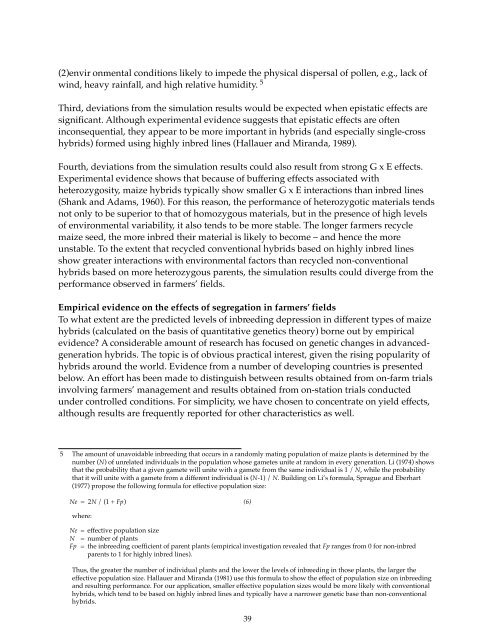A Review of the Evidence - Search CIMMYT repository
A Review of the Evidence - Search CIMMYT repository
A Review of the Evidence - Search CIMMYT repository
Create successful ePaper yourself
Turn your PDF publications into a flip-book with our unique Google optimized e-Paper software.
(2)␣envir onmental conditions likely to impede <strong>the</strong> physical dispersal <strong>of</strong> pollen, e.g., lack <strong>of</strong>wind, heavy rainfall, and high relative humidity. 5Third, deviations from <strong>the</strong> simulation results would be expected when epistatic effects aresignificant. Although experimental evidence suggests that epistatic effects are <strong>of</strong>teninconsequential, <strong>the</strong>y appear to be more important in hybrids (and especially single-crosshybrids) formed using highly inbred lines (Hallauer and Miranda, 1989).Fourth, deviations from <strong>the</strong> simulation results could also result from strong G x E effects.Experimental evidence shows that because <strong>of</strong> buffering effects associated withheterozygosity, maize hybrids typically show smaller G x E interactions than inbred lines(Shank and Adams, 1960). For this reason, <strong>the</strong> performance <strong>of</strong> heterozygotic materials tendsnot only to be superior to that <strong>of</strong> homozygous materials, but in <strong>the</strong> presence <strong>of</strong> high levels<strong>of</strong> environmental variability, it also tends to be more stable. The longer farmers recyclemaize seed, <strong>the</strong> more inbred <strong>the</strong>ir material is likely to become – and hence <strong>the</strong> moreunstable. To <strong>the</strong> extent that recycled conventional hybrids based on highly inbred linesshow greater interactions with environmental factors than recycled non-conventionalhybrids based on more heterozygous parents, <strong>the</strong> simulation results could diverge from <strong>the</strong>performance observed in farmers’ fields.Empirical evidence on <strong>the</strong> effects <strong>of</strong> segregation in farmers’ fieldsTo what extent are <strong>the</strong> predicted levels <strong>of</strong> inbreeding depression in different types <strong>of</strong> maizehybrids (calculated on <strong>the</strong> basis <strong>of</strong> quantitative genetics <strong>the</strong>ory) borne out by empiricalevidence? A considerable amount <strong>of</strong> research has focused on genetic changes in advancedgenerationhybrids. The topic is <strong>of</strong> obvious practical interest, given <strong>the</strong> rising popularity <strong>of</strong>hybrids around <strong>the</strong> world. <strong>Evidence</strong> from a number <strong>of</strong> developing countries is presentedbelow. An effort has been made to distinguish between results obtained from on-farm trialsinvolving farmers’ management and results obtained from on-station trials conductedunder controlled conditions. For simplicity, we have chosen to concentrate on yield effects,although results are frequently reported for o<strong>the</strong>r characteristics as well.5 The amount <strong>of</strong> unavoidable inbreeding that occurs in a randomly mating population <strong>of</strong> maize plants is determined by <strong>the</strong>number (N) <strong>of</strong> unrelated individuals in <strong>the</strong> population whose gametes unite at random in every generation. Li (1974) showsthat <strong>the</strong> probability that a given gamete will unite with a gamete from <strong>the</strong> same individual is 1 / N, while <strong>the</strong> probabilitythat it will unite with a gamete from a different individual is (N-1) / N. Building on Li’s formula, Sprague and Eberhart(1977) propose <strong>the</strong> following formula for effective population size:Ne = 2N / (1 + Fp) (6)where:Ne = effective population sizeN = number <strong>of</strong> plantsFp = <strong>the</strong> inbreeding coefficient <strong>of</strong> parent plants (empirical investigation revealed that Fp ranges from 0 for non-inbredparents to 1 for highly inbred lines).Thus, <strong>the</strong> greater <strong>the</strong> number <strong>of</strong> individual plants and <strong>the</strong> lower <strong>the</strong> levels <strong>of</strong> inbreeding in those plants, <strong>the</strong> larger <strong>the</strong>effective population size. Hallauer and Miranda (1981) use this formula to show <strong>the</strong> effect <strong>of</strong> population size on inbreedingand resulting performance. For our application, smaller effective population sizes would be more likely with conventionalhybrids, which tend to be based on highly inbred lines and typically have a narrower genetic base than non-conventionalhybrids.39
















